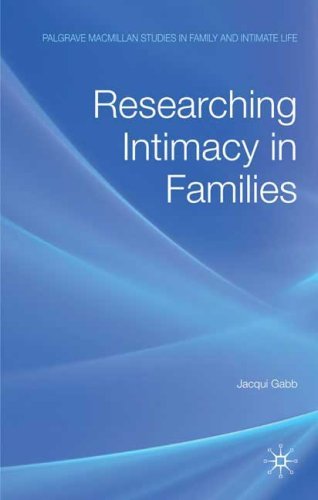Researching Intimacy in Families
J, Gabb
Palgrave Macmillan Ltd, Basingstoke
2008
9780230527225 (hb)
Order this book?
 The study of relational life confronts us with both conceptual and methodological challenges. The conceptual exploration of intimacy is strictly linked to the design of appropriate methodological tools to investigate how intimacy is defined and experienced in the real world. Every methodological approach, qualitative or quantitative, sheds just a partial light on the complexity of the processes shaping intimacy. This complexity is, in part, linked to intimacy crossing and challenging the simplistic views of private-public boundaries. As Jacqui Gabb extensively discusses in her recent book, in order to understand where, when, how and why intimacy is experienced in certain ways – that is, in order to sketch an holistic picture of interpersonal relationships – a wide variety of (mainly qualitative) methods have to be combined in specific and innovative forms. The innovation in methods triggers a dynamic process between conceptual definitions of intimacy and the tools meant to investigate it.
The study of relational life confronts us with both conceptual and methodological challenges. The conceptual exploration of intimacy is strictly linked to the design of appropriate methodological tools to investigate how intimacy is defined and experienced in the real world. Every methodological approach, qualitative or quantitative, sheds just a partial light on the complexity of the processes shaping intimacy. This complexity is, in part, linked to intimacy crossing and challenging the simplistic views of private-public boundaries. As Jacqui Gabb extensively discusses in her recent book, in order to understand where, when, how and why intimacy is experienced in certain ways – that is, in order to sketch an holistic picture of interpersonal relationships – a wide variety of (mainly qualitative) methods have to be combined in specific and innovative forms. The innovation in methods triggers a dynamic process between conceptual definitions of intimacy and the tools meant to investigate it.
According to this perspective, her book aims to bridge the gap between methodology handbooks and monographs. She offers us a text in which methods are constantly in dialogue with theoretical perspectives - through the critical analysis of the empirical data they enable to collect. Chapter One introduces the central ideas developed in the book and introduces the research project whose design and empirical data are at the basis of the book ('Behind Closed Doors: Researching Intimacy and Sexuality in Families'). Chapter Two outlines the emergent fields of family studies and childhood research. What the author highlights is how changes in the understandings of what families are (from functionalist approaches to the idea of families as relationships forged through everyday practices) have affected the scope and framing of research. Chapter Three looks at key qualitative methodological approaches usually adopted in the field of family studies: participatory approaches, writing methods, visual techniques, participant observation, interviews, vignettes and focus groups. Innovative approaches are introduced and in particular mixed-methods, which are meant to create synergy among data collected through different approaches. In Chapter Four reviews conceptualisations of intimacy and sexuality, addressing the issue of how sociological research has studied the interiority of everyday family experience. Chapters Five to Seven discuss the theoretical and methodological assumptions illustrated in the previous Chapters. This is written from the perspective of the empirical data collected through the research project presented in Chapter One. Chapter Five aims to open out key theoretical debates on intimacy in families such as: investment in the child, the role of friends, the significant others (included pets), and the dimension of time. The latter is seen as crucial in creating and maintaining families and in shaping boundaries around public-private experiences of intimacy. The importance of taking into account gender differences in the way feelings are expressed is highlighted as an important factor when analysing qualitative data. In Chapter Six, the author returns to methodological debates: through close analysis of empirical data she illustrates how different methods produce distinctive kinds of data. Methods like the emotion map, biographical narrative interviews, and focus group discussion are extensively illustrated in their specific contribution to the understanding of intimacy. What the author stresses is how a mixed-methods approach can produce a more accurate description (and comprehension) of the dynamics at work in shaping intimacy, in particular concerning the public-private interplay. The concluding Chapter Seven points to areas of future research (e.g. instrumental affective strategies in child-centred relationships and their effects on children and couples) and illustrates through case-study analysis of mixed-methods data from one specific family how multi-dimensional data can help capturing the dynamic process of family relationality.
The book is an excellent systematisation of both the debates shaping the field of family studies and the ones concerning methods to explore relational life and sensitive topics. It will make for interesting reading even for scholars not directly concerned with topics related to family. Although the book is structured so that the reader can rapidly isolate and have access to the content she/he is more interested in (always with a rich apparatus of references at her/his disposal), the dialogue between theoretical and methodological issues which structures the book is what makes the reading highly recommended, especially to postgraduates and new researchers.
Laura Centemeri
University of Coimbra, Portugal |

